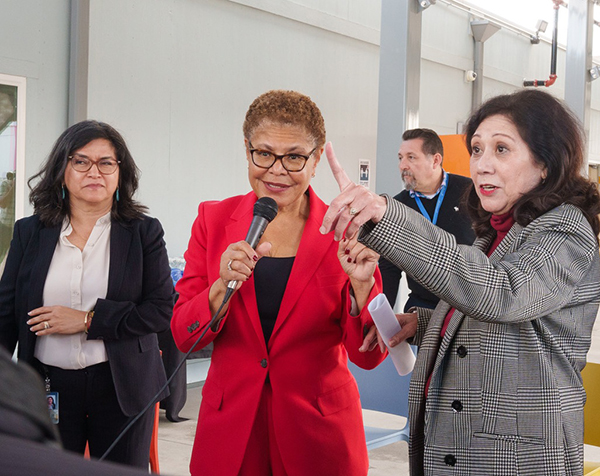By Solomon O. Smith
Contributing Writer
LOS ANGELES — Mayor Karen Bass hosted Black mayors from different parts of the country Feb. 2, giving them a tour of a new, temporary housing complex in Chinatown that serves the homeless.
The Hilda L. Solis Care First Village, named after Los Angeles County Supervisor Hilda Solis, was described as a model of an affordable, effective and nimble solution to addressing the intersecting mental health and homelessness crises gripping cities around the country.
The development features an innovative design, using modular units, and offers wraparound mental health care and social services.
Staff and business leaders were among the guests that attended the event, along with Bass, Solis and former state legislator Kevin Murray, who is president and CEO of the Weingart Center Association, which operates the village.
“I am thrilled to welcome members of the African American Mayors Association to Los Angeles” Bass said. “I want to thank AAMA President and Mount Vernon Mayor Shawyn Patterson-Howard and all of the other mayors for coming to Los Angeles to discuss our rich and diverse culture, social and economic accomplishments and challenges, and how policy makers and cultural leaders can come together to solve the challenges that cities face.”
Long Beach Mayor Rex Richardson, Inglewood Mayor James Butts, Compton Mayor Emma Sharif, Culver City Mayor Yasmine-Imani McMorrin, Gardena Mayor Tasha Cerda, Carson Mayor Lula Davis-Holmes and Lawndale Mayor Robert Pullen-Miles were among those attending the meeting, along with several out-of-state mayors including Chicago Mayor Brandon Johnson, Seattle Mayor Bruce Harrell, Atlanta Mayor Andre Dickens, Savannah Mayor Van Johnson and Charlotte Mayor Vi Lyles.
The Hilda L. Solis Care First Village is one of the Weingart Center’s 15 locations in California designed to address homelessness. Located next to the Los Angeles’ county jail known as the Twin Towers Correctional Facility, the village opened in May 2021 with $51 million from pandemic relief funds and $6 million from Los Angeles County discretionary funds, according to Solis.
The three-story facility was conceived, approved and built in six months due to a combination of prefabricated units, custom made trailers and 60 shipping containers. Modular designs lowered costs per unit from $531,373 down to $245,689.
Each room is private and includes a television and shower, allowing residents to have personal space and reduce arguments and conflict. There are 232 units, 10 of which are reserved for use by the Los Angeles District Attorney’s Office and Project 180, a program which seeks to lower recidivism rates.
Site director Chris Castaneda explained that the purpose of the interim housing is to usher residents into permanent housing. The population covers a wide range including the elderly, who make up about 23% and each person has a different set of needs.
“So far we have placed about 25% of our clients into permanent housing,” Casteneda said. “But we’re very happy to have that in the 25% range, which might sound like a small number. But, when you look at all the barriers that we have to work through, it’s pretty good.”
Murray, who is a former chair of the California Legislative Black Caucus, led the mayors’ tour and answered questions. He explained the concepts behind many of the facilities spaces, and discussed philosophies leaders and staff ascribe to at the village.
The amenities of the facility are part of a humanizing approach to addressing homelessness, according to Murray, who guided visitors through safe outdoor areas, views of the living spaces and a dog park.
The center also includes laundry facilities, an on-site kitchen and parking spaces for residents. There are even veterinary services for pets.
For some staying at the facility, this model has afforded them the opportunity to focus on healing.
Judith A. Brown’s room was one of the highlights of the tour. Brown is a cancer survivor and says the services and security she found at the center gave her space to recuperate. She is in remission and has grown her hair back and has had visits from her daughter.
“I mean, since I’ve been at the shelter, I’ve concentrated on my health and mental health,” Brown said.
Another resident said he has been in the village for two years and has not received enough help.
Leaders say the village is not designed as a catch-all. So those with more severe medical or mental issues are referred to locations better equipped for them, according to Murray. It costs about $70 to $80 per person, per day to operate. That includes security and case management.
“I think one of the things about homelessness is you need different kinds of houses,” Murray said. “I think the biggest flaw in homeless policy right now is the cookie cutter approach. Certainly, do some of that but you got to look at every site, every neighborhood, every community, every city a little bit differently and see what works for them.”
For some, the facility is a second chance at life.
Tommy Mitchell is 67 and disabled. He has been at the facility for more than three months but was on the street for two years. A few months ago, he was sleeping in his truck and was robbed by two men who took his money and cut him several times across his stomach.
When he was taken to the hospital he was connected to the village where he received help navigating the city’s housing process. On the day of the tour, he received some good news — he qualified for an apartment. His counselor gave him the good news in person.
“This was a blessing. This place really helped me a whole lot,” Mitchell said. This place is a good place if you want help. You follow the steps, do what they ask you and you’ll win.”
Solomon O. Smith is a reporter for California Black Media. City News Service also contributed to this story.











